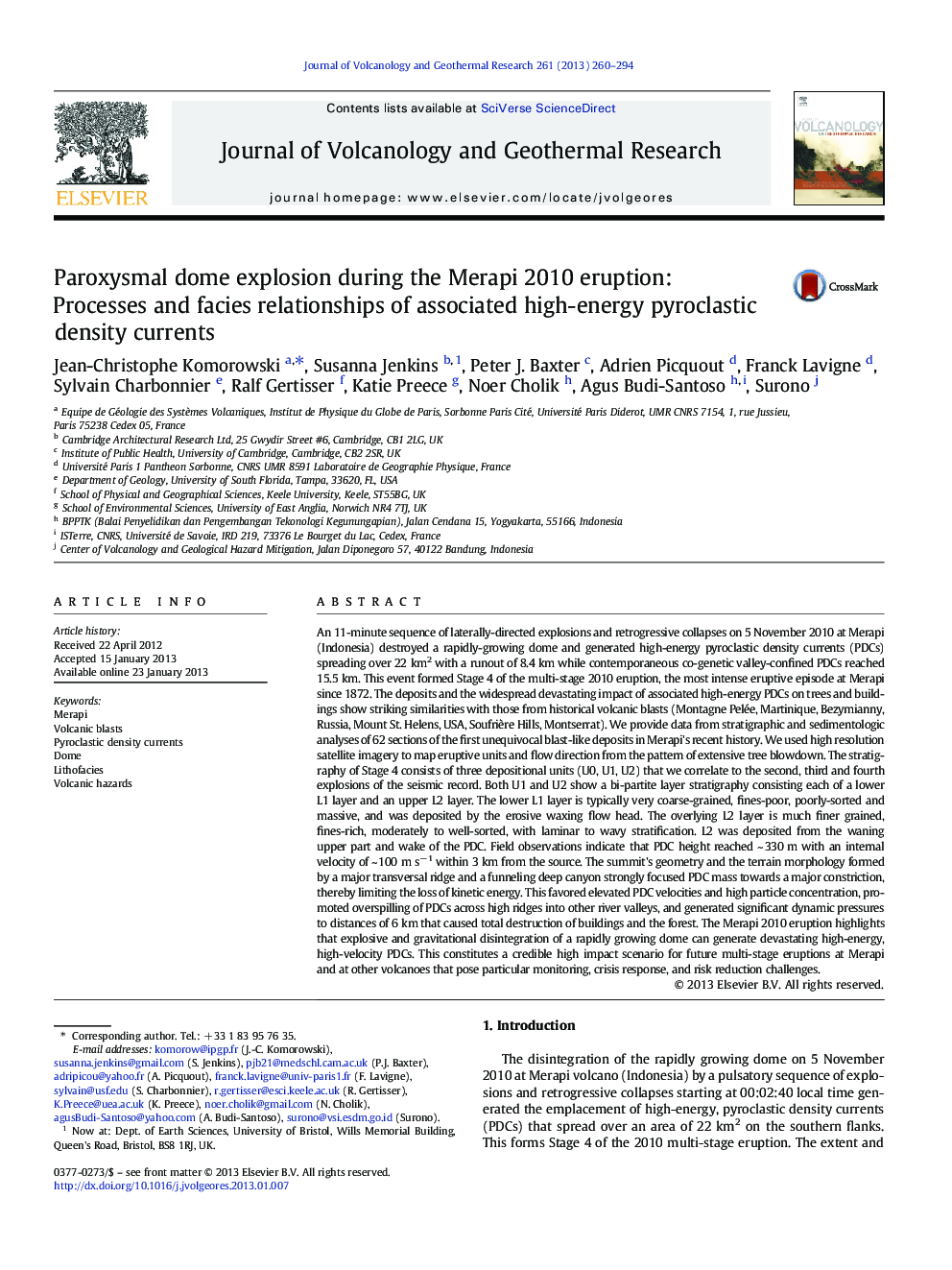| کد مقاله | کد نشریه | سال انتشار | مقاله انگلیسی | نسخه تمام متن |
|---|---|---|---|---|
| 4714698 | 1638360 | 2013 | 35 صفحه PDF | دانلود رایگان |

An 11-minute sequence of laterally-directed explosions and retrogressive collapses on 5 November 2010 at Merapi (Indonesia) destroyed a rapidly-growing dome and generated high-energy pyroclastic density currents (PDCs) spreading over 22 km2 with a runout of 8.4 km while contemporaneous co-genetic valley-confined PDCs reached 15.5 km. This event formed Stage 4 of the multi-stage 2010 eruption, the most intense eruptive episode at Merapi since 1872. The deposits and the widespread devastating impact of associated high-energy PDCs on trees and buildings show striking similarities with those from historical volcanic blasts (Montagne Pelée, Martinique, Bezymianny, Russia, Mount St. Helens, USA, Soufrière Hills, Montserrat). We provide data from stratigraphic and sedimentologic analyses of 62 sections of the first unequivocal blast-like deposits in Merapi's recent history. We used high resolution satellite imagery to map eruptive units and flow direction from the pattern of extensive tree blowdown. The stratigraphy of Stage 4 consists of three depositional units (U0, U1, U2) that we correlate to the second, third and fourth explosions of the seismic record. Both U1 and U2 show a bi-partite layer stratigraphy consisting each of a lower L1 layer and an upper L2 layer. The lower L1 layer is typically very coarse-grained, fines-poor, poorly-sorted and massive, and was deposited by the erosive waxing flow head. The overlying L2 layer is much finer grained, fines-rich, moderately to well-sorted, with laminar to wavy stratification. L2 was deposited from the waning upper part and wake of the PDC. Field observations indicate that PDC height reached ~ 330 m with an internal velocity of ~ 100 m s− 1 within 3 km from the source. The summit's geometry and the terrain morphology formed by a major transversal ridge and a funneling deep canyon strongly focused PDC mass towards a major constriction, thereby limiting the loss of kinetic energy. This favored elevated PDC velocities and high particle concentration, promoted overspilling of PDCs across high ridges into other river valleys, and generated significant dynamic pressures to distances of 6 km that caused total destruction of buildings and the forest. The Merapi 2010 eruption highlights that explosive and gravitational disintegration of a rapidly growing dome can generate devastating high-energy, high-velocity PDCs. This constitutes a credible high impact scenario for future multi-stage eruptions at Merapi and at other volcanoes that pose particular monitoring, crisis response, and risk reduction challenges.
► Explosive disintegration of pressurized fast-growing volcanic dome (blast)
► Emplacement of devastating high-energy, high-velocity pyroclastic density currents
► Topography strongly affected PDC dynamics (velocity, density, dynamic pressure).
► Most intense cumulative eruption impacts (population, buildings, trees) at Merapi since 1872.
► Credible scenario to include in hazards and risk mitigation of future eruption
Journal: Journal of Volcanology and Geothermal Research - Volume 261, 1 July 2013, Pages 260–294